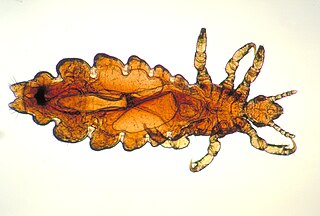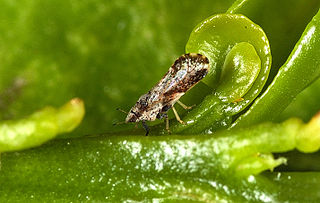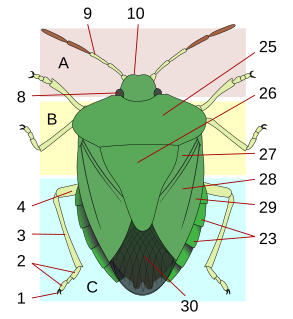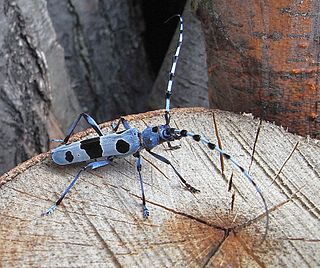
Louse is the common name for members of the order Phthiraptera, which contains nearly 5,000 species of wingless insect. Lice are obligate parasites, living externally on warm-blooded hosts which include every species of bird and mammal, except for monotremes, pangolins, and bats. Lice are vectors of diseases such as typhus.

The crab louse or pubic louse is an insect that is an obligate ectoparasite of humans, feeding exclusively on blood. The crab louse usually is found in the person's pubic hair. Although the louse cannot jump, it can also live in other areas of the body that are covered with coarse hair, such as the eyelashes. It is of the order Psocodea.

Pediculosis is an infestation of lice. The condition can occur in almost any species of warm-blooded animal, including humans. Although pediculosis in humans may properly refer to lice infestation of any part of the body, the term is sometimes used loosely to refer to pediculosis capitis, the infestation of the human head with the specific head louse.

The Hemiptera or true bugs are an order of insects comprising some 50,000 to 80,000 species of groups such as the cicadas, aphids, planthoppers, leafhoppers, and shield bugs. They range in size from 1 mm (0.04 in) to around 15 cm (6 in), and share a common arrangement of sucking mouthparts. The name "true bugs" is sometimes limited to the suborder Heteroptera. Many insects commonly known as "bugs" belong to other orders; for example, the lovebug is a fly, while the May bug and ladybug are beetles.

Psyllidae, the jumping plant lice or psyllids, are a family of small plant-feeding insects that tend to be very host-specific, i.e. each plant-louse species only feeds on one plant species (monophagous) or feeds on a few closely related plants (oligophagous). Together with aphids, phylloxerans, scale insects and whiteflies, they form the group called Sternorrhyncha, which is considered to be the most "primitive" group within the true bugs (Hemiptera). They have traditionally been considered a single family, Psyllidae, but recent classifications divide the group into a total of seven families; the present restricted definition still includes more than 70 genera in the Psyllidae. Psyllid fossils have been found from the Early Permian before the flowering plants evolved. The explosive diversification of the flowering plants in the Cretaceous was paralleled by a massive diversification of associated insects, and many of the morphological and metabolic characters that the flowering plants exhibit may have evolved as defenses against herbivorous insects.

Triozidae is one of seven families collectively referred to as jumping plant lice. They have traditionally been considered part of a single family, Psyllidae, but recent classifications divide the group into a total of seven families; most of the genera remain in the Psyllidae, but Triozidae is the second-largest family in the group, containing 27 genera, and a number of pest species.
Aacanthocnema is a genus of bugs from the jumping plant lice family (Triozidae). The genus is endemic to Australia, and currently contains six species.

Diaphorina is an Old World genus of sap-sucking hemipteran bugs in the family, Liviidae. It includes an important pest of citrus: the Asian citrus psyllid, D. citri.

Cardiaspina fiscella, the brown basket lerp or brown lace lerp, is a jumping plant louse species in the genus Cardiaspina originally found in Australia. It spread to New Zealand where it was found in 1996 near the Auckland airport. It feeds on eucalyptus, especially swamp mahogany, and is found in Victoria, eastern New South Wales, and southeastern Queensland, as well as the capital territory (ACT) around Canberra and on Norfolk Island. Cardiaspina fiscella has five nymphal instars, and as the instars moult they add a layer to their outside covering (casing), known as the "lerp".
Aacanthocnema burckhardti is a species of jumping plant lice, first found on plants of the genus Allocasuarina in Australia. The species is characterised by exhibiting an elongate habitus; short Rs and short cubital forewing cells; ventral genal processes beneath the apical margin of its vertex; short antennae; and nymphs that are elongate and very sclerotised (scale-like). It lacks hinaria on its eighth antennal segment as well as sclerotised spurs on its hind tibia. Females of the species lack a posterior apical hook on their proctiger.
Aacanthocnema huegelianae is a species of jumping plant lice, first found on plants of the genus Allocasuarina in Australia. The species is characterised by exhibiting an elongate habitus; short Rs and short cubital forewing cells; ventral genal processes beneath the apical margin of its vertex; short antennae; and nymphs that are elongate and very sclerotised (scale-like). It lacks hinaria on its eighth antennal segment as well as sclerotised spurs on its hind tibia. Females of the species lack a posterior apical hook on their proctiger.
Aacanthocnema luehmannii is a species of jumping plant louse, first found on plants of the genus Allocasuarina in Australia. The species is characterised by exhibiting an elongate habitus; short Rs and short cubital forewing cells; ventral genal processes beneath the apical margin of its vertex; short antennae; and nymphs that are elongate and very sclerotised (scale-like). It lacks hinaria on its eighth antennal segment as well as sclerotised spurs on its hind tibia. Females of the species lack a posterior apical hook on their proctiger.
Aacanthocnema torulosae is a species of jumping plant lice, first found on plants of the genus Allocasuarina in Australia. The species is characterised by exhibiting an elongate habitus; short Rs and short cubital forewing cells; ventral genal processes beneath the apical margin of its vertex; short antennae; and nymphs that are elongate and very sclerotised (scale-like). It lacks hinaria on its eighth antennal segment as well as sclerotised spurs on its hind tibia. Females of the species lack a posterior apical hook on their proctiger.
Acanthocasuarina acutivalvis is a species of jumping plant louse, first found on plants of the genus Allocasuarina in Australia. The species is characterised by exhibiting an elongate habitus; short Rs and short cubital forewing cells; ventral genal processes beneath the apical margin of its vertex; short antennae; and nymphs that are elongate and very sclerotised (scale-like). It possesses rhinaria on its fourth, sixth, eighth and ninth antennal segments; the species' hind tibia has one outer and two inner spurs, while the female's proctiger carries an apical hook posteriorly.
Acanthocasuarina campestris is a species of jumping plant louse, first found on plants of the genus Allocasuarina in Australia. The species is characterised by exhibiting an elongate habitus; short Rs and short cubital forewing cells; ventral genal processes beneath the apical margin of its vertex; short antennae; and nymphs that are elongate and very sclerotised (scale-like). It possesses rhinaria on its fourth, sixth, eighth and ninth antennal segments; the species' hind tibia has one outer and two inner spurs, while the female's proctiger carries an apical hook posteriorly.
Acanthocasuarina diminutae is a species of jumping plant lice, first found on plants of the genus Allocasuarina in Australia. The species is characterised by exhibiting an elongate habitus; short Rs and short cubital forewing cells; ventral genal processes beneath the apical margin of its vertex; short antennae; and nymphs that are elongate and very sclerotised (scale-like). It possesses rhinaria on its fourth, sixth, eighth and ninth antennal segments; the species' hind tibia has one outer and two inner spurs, while the female's proctiger carries an apical hook posteriorly.
Acanthocasuarina muellerianae is a species of jumping plant lice, first found on plants of the genus Allocasuarina in Australia. The species is characterised by exhibiting an elongate habitus; short Rs and short cubital forewing cells; ventral genal processes beneath the apical margin of its vertex; short antennae; and nymphs that are elongate and very sclerotised (scale-like). It possesses rhinaria on its fourth, sixth, eighth and ninth antennal segments; the species' hind tibia has one outer and two inner spurs, while the female's proctiger carries an apical hook posteriorly.
Acanthocasuarina tasmanica is a species of jumping plant louse, first found on plants of the genus Allocasuarina in Australia. The species is characterised by exhibiting an elongate habitus; short Rs and short cubital forewing cells; ventral genal processes beneath the apical margin of its vertex; short antennae; and nymphs that are elongate and very sclerotised (scale-like). It possesses rhinaria on its fourth, sixth, eighth and ninth antennal segments; the species' hind tibia has one outer and two inner spurs, while the female's proctiger carries an apical hook posteriorly.
Acanthocasuarina verticillatae is a species of jumping plant lice, first found on plants of the genus Allocasuarina in Australia. The species is characterised by exhibiting an elongate habitus; short Rs and short cubital forewing cells; ventral genal processes beneath the apical margin of its vertex; short antennae; and nymphs that are elongate and very sclerotised (scale-like). It possesses rhinaria on its fourth, sixth, eighth and ninth antennal segments; the species' hind tibia has one outer and two inner spurs, while the female's proctiger carries an apical hook posteriorly.
Acanthocasuarina is a genus of bugs from the jumping plant lice family (Triozidae). The genus is endemic to Australia, and currently contains six species.













